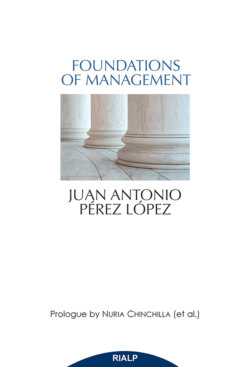Читать книгу Foundations of management - Juan Antonio Pérez López - Страница 11
На сайте Литреса книга снята с продажи.
Mechanical or technical system models
ОглавлениеIn a technical system, the organization is considered to be a simple coordination of human actions whose goal is to produce and distribute a series of objects and/or services. In fact, given that human actions are only organized to produce something outside of themselves (that is, their objective side, ignoring their subjective side or the impact they produce on the subject who performs them), a technical system organizes the interchange of “objects” or “things” (some of these being human actions).
The organization thus appears as a more or less complex machine that produces some things and consumes others. The particular way in which it produces things is determined by the production system, which consists of a set of roles or functions that the system will attempt to specify as accurately as possible (as with parts or components of a machine). The nature of consumption is determined by the incentive system, which one attempts to relate to the production system so that what a person receives corresponds as closely as possible to his productivity: that is, his contribution to the production system's operations.
A technical system does not take into account the personal motives, needs or interactions which are not included in the production system. In fact, any relationship that might exist is established between roles or functions, not between people. A technical system only encompasses the formal organization and ignores—leaves outside of its field of analysis and explanation—all those informal aspects which, in addition to the formal organization, are included within the real organization.
On the basis of this abstraction, technical systems can achieve greater precision in the analysis of all issues having to do with the achievement of maximum production and minimum consumption. Let us not forget, however, that the assumption underlying this analysis is that everything not considered in the model—the entire range of people's non-formalized needs, motives and interactions-is irrelevant in the concrete case to which the results of the analysis are applied.
Every experienced manager has had to face, on many occasions, opposition by some members of his organization when he tries to replace one procedure with another that is “technically” better. The same basic error underlies many of these difficulties, namely, thinking that what appears best in the reduced image offered by the technical system is also best in that complex reality which is the real organization.
The processes of purpose definition, communication and motivation are considerably simplified in a technical system. Purpose definition only seeks to establish operating goals which, depending upon specific circumstances, may be attained by the production system. This process is usually called strategic planning, and it seeks to couple the capacities of the production system with the particular state of the environment prevailing at a given time. The goal is to achieve the most production with the least consumption. The communication process seeks only to convey the necessary information to the various decision centers of the production system, in order to enable the operating goals to be achieved by means of joint action. The motivation process is reduced to the use of an incentive system as a means of distributing incentives: that is, arranging things so that the amount a person receives from the organization increases in accordance with his contribution within the production system (and also so that the amount he receives does not fall below the minimum acceptable to motivate him to contribute at all).
A large portion of business management literature—about the entire management process or certain aspects of it—bases its analysis on a picture of organizational processes which uses the technical system as its underlying model or paradigm. Although lip service is often paid to the need to take into account other aspects of organizations, the core of the discussion is based on an explanation of the processes as reflected in a technical system.
The use of these models as the conceptual basis of a particular author's statements is readily recognizable. One need only look at the ultimate goal assigned, explicitly or implicitly, to the organization. Whenever this goal is reduced to the optimization of the production/consumption ratio (attempting to optimize production at certain levels of consumption, or to minimize the consumption of resources used for a certain level of production, or to maximize the difference between the two), the underlying model is the technical system.
The models, as such, vary considerably, but they all have this feature in common. Their basic differences lie in the various postulates they make regarding the nature of human knowledge, the role of knowledge in decisions, and the way in which decisions are made. The image of the person—the model of man—that they use will range from the one traditionally used in economics (economic man), to the slightly more complete image (since it takes into account—at least in part—the limitations imposed on human knowledge) introduced by Herbert Simon under the name administrative man1.
Any of these models of the human being is consistent with our model of an organization conceived of as a technical system, since the differences used to establish our classifications are to be found at a deeper level: that of the motives for human action and their relationship to human needs.
